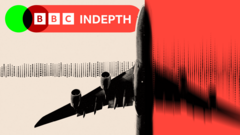Recent experiences in air travel suggest a worrying trend: turbulence is becoming more frequent and intense, creating challenges for airlines and safety for passengers. A recent flight from London to Singapore illustrated this reality. Passenger Andrew Davies described the jarring turbulence he experienced as akin to a rollercoaster, with sudden drops that left fellow travelers injured and, tragically, one man dead from a heart attack.
While fatalities due to turbulence remain rare, the number of injuries is alarming. Since 2009, the National Transportation Safety Board has reported over 200 severe injuries, many of which were sustained during turbulence events. As climate change continues to alter atmospheric dynamics, experts warn that the aviation industry must prepare for a future with potentially double or triple the instances of severe turbulence. Professor Paul Williams from the University of Reading notes that what currently lasts 10 minutes could increase to 20 or 30 minutes.
Air routes between the UK and the US, Canada, and the Caribbean have seen a 55% increase in severe turbulence over the last 40 years. Preliminary studies indicate that areas in East Asia, North Africa, and the Middle East may also experience similar trends. The results of climate change—such as temperature variations and increased storm activity—contribute to both convective turbulence, generated by thunderstorms, and clear-air turbulence, which is often unpredictable.
The aviation industry is confronting more than just immediate passenger discomfort; the economic ramifications of increased turbulence are serious as well. From the cost of repairing aircraft to compensations for flight delays, airlines face significant financial implications. Eurocontrol, a European aviation organization, reports that weather-related diversions could lead to an estimated extra million kilometers flown by airlines, contributing to higher carbon footprints.
As turbulence becomes more common, strategies created by airlines aim to minimize its impact. Enhanced forecasting methods now anticipate about 75% of clear-air turbulence based on flight plans informed by atmospheric data. Some airlines are altering service procedures and even experimenting with new technology to mitigate turbulence—such as detecting turbulent air and adjusting wing flaps accordingly.
While fears related to increased turbulence persist among passengers, experts generally agree that air travel is still safe. Nevertheless, those who have faced severe turbulence firsthand, like Andrew Davies, remain wary, balancing their love for flying with the understanding that preparation is key. With adaptations being made both in operational practices and technology, the airline industry continues to navigate the bumpy skies ahead.






















